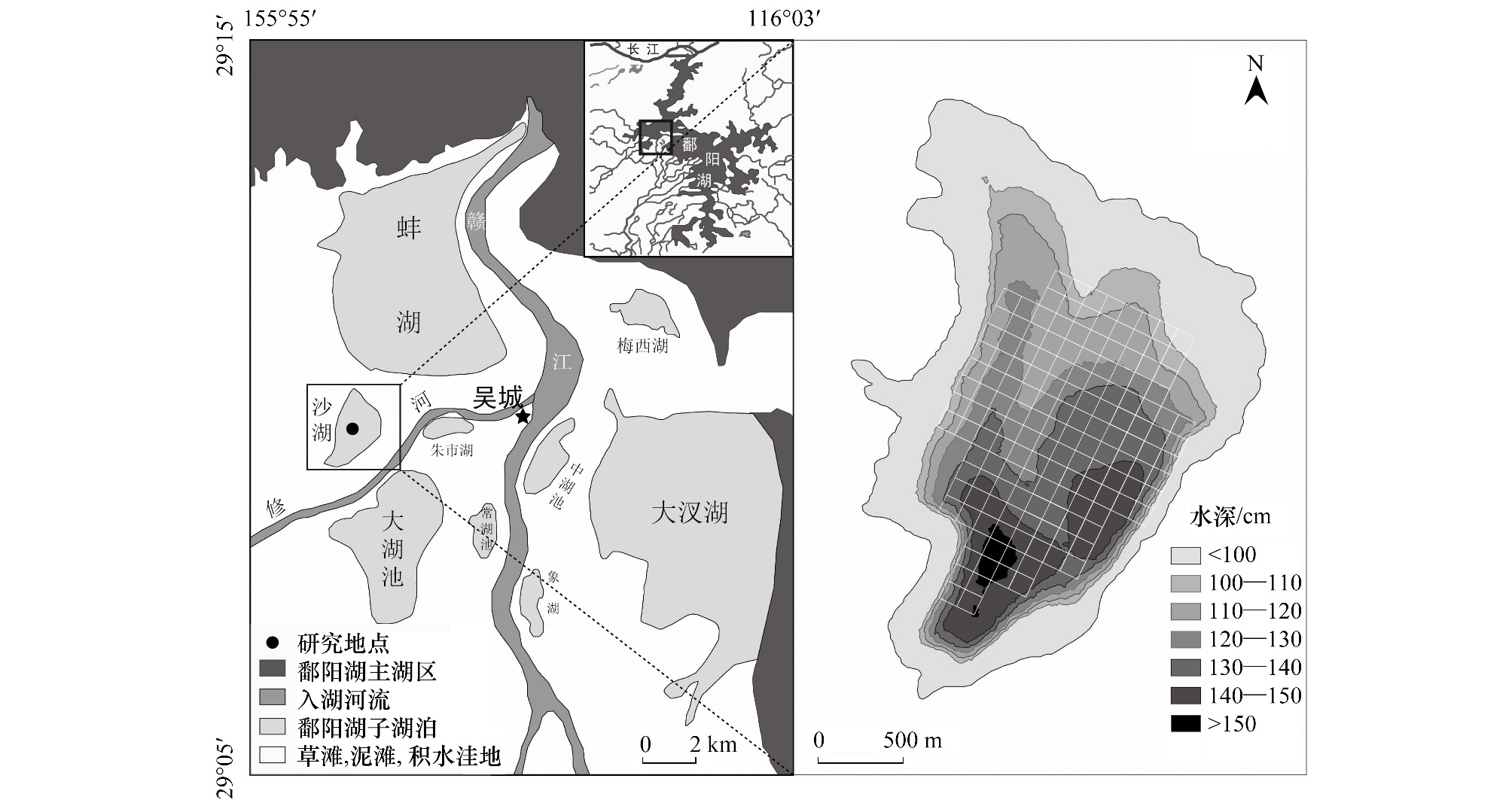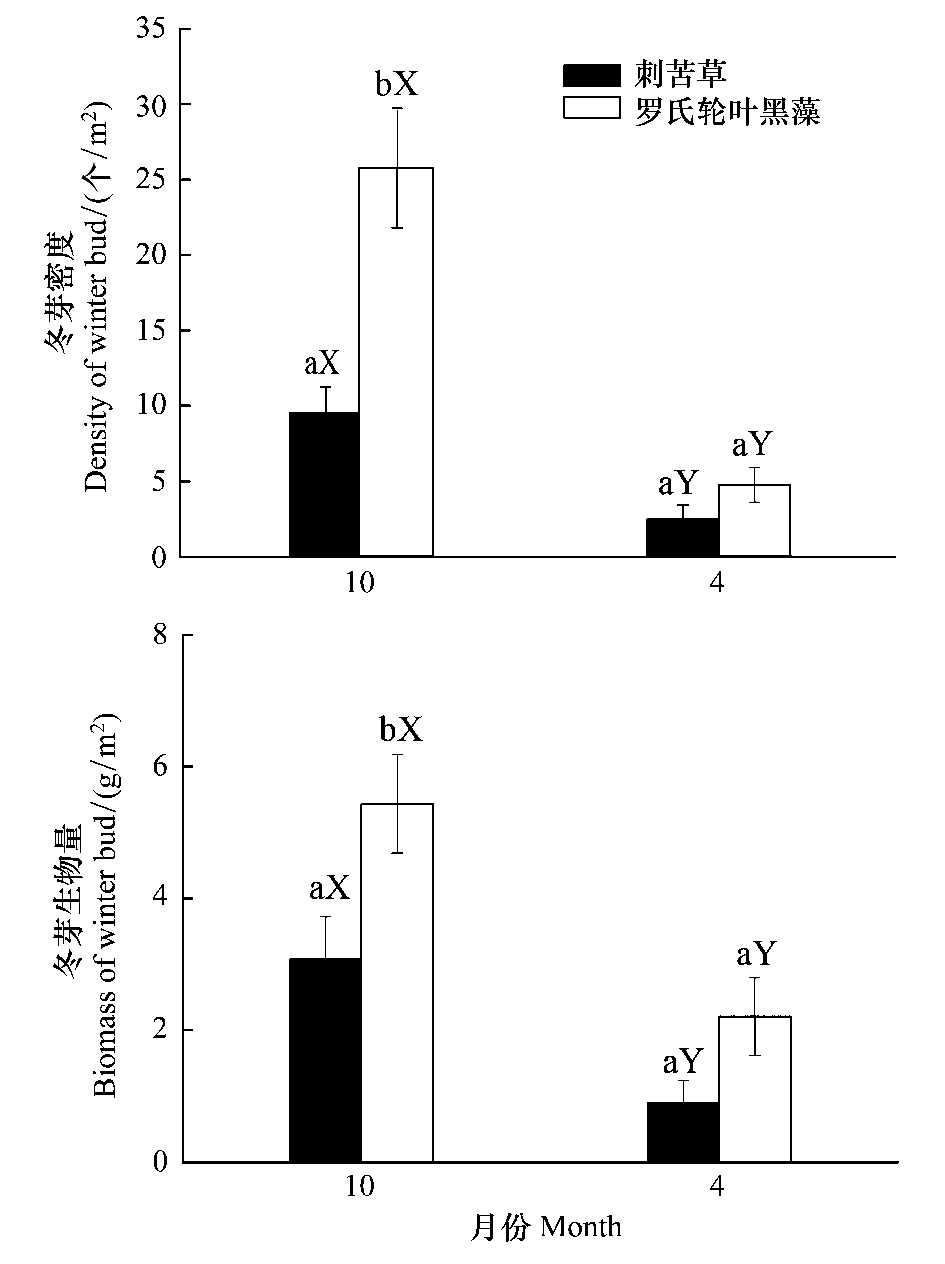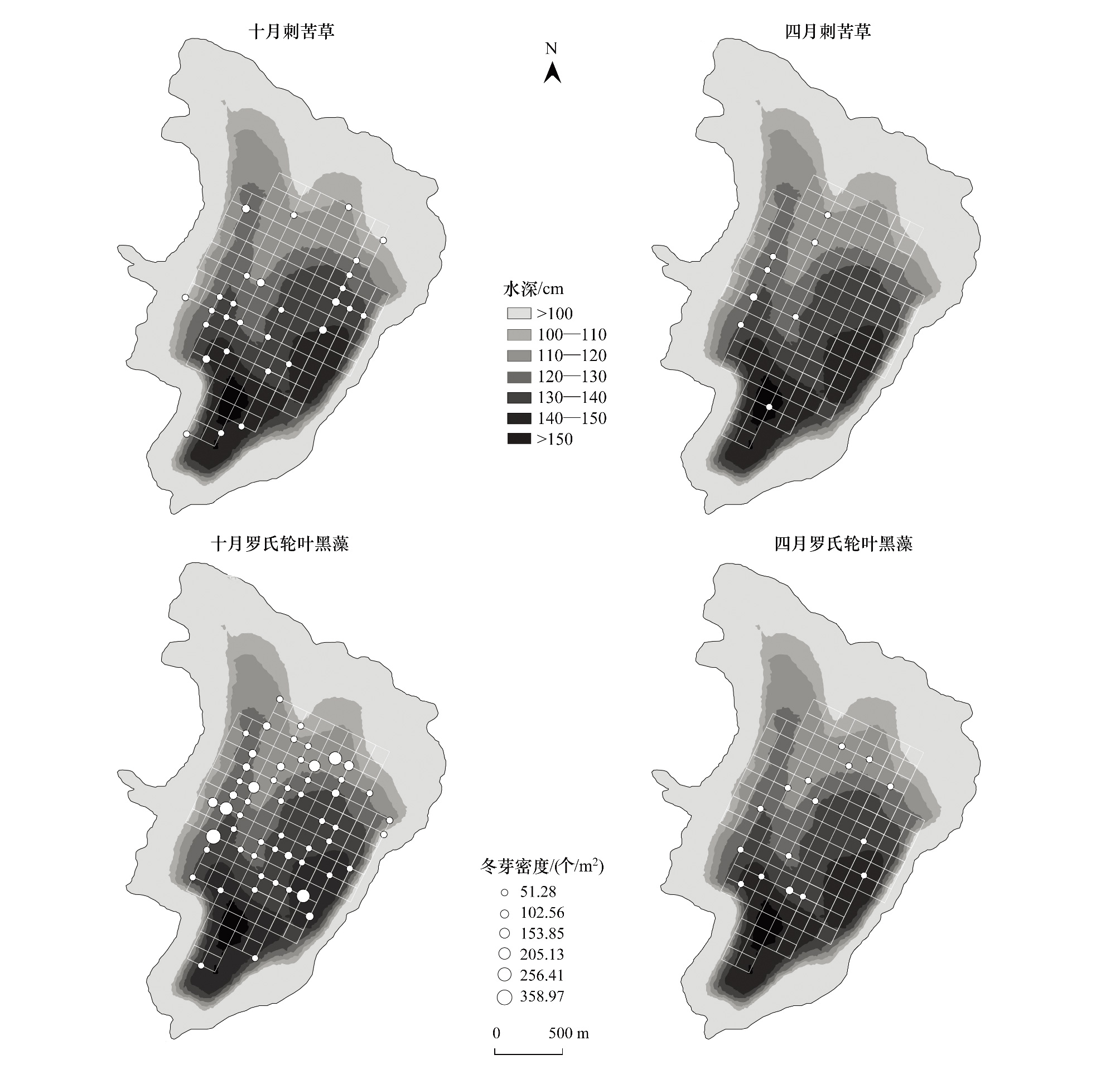文章信息
- 张笑辰, 秦海明, 金斌松, 陈家宽, 吴建东, 刘观华, 马志军
- ZHANG Xiaochen, QIN Haiming, JIN Binsong, CHEN Jiakuan, WU Jiandong, LIU Guanhua, MA Zhijun
- 鄱阳湖浅碟湖泊沉水植物冬芽的分布及对植食水鸟的食物贡献
- Distribution in winter buds of submerged macrophyte and their contribution for herbivorous waterfowl in a shallow dish lake of Poyang Lake
- 生态学报, 2014, 34(22): 6589-6596
- Acta Ecologica Sinica, 2014, 34(22): 6589-6596
- http://dx.doi.org/10.5846/stxb201310242563
-
文章历史
- 收稿日期:2013-10-24
- 网络出版日期:2014-3-14
2. 江西鄱阳湖国家级自然保护区管理局, 南昌 330038;
3. 复旦大学生物多样性科学研究所, 生物多样性与生态工程教育部重点实验室, 上海 200433
2. Jiangxi Poyang Lake National Nature Reserve, Nanchang 330038, China;
3. Institute of Biodiversity Science, Ministry of Education Key Laboratory f or Biodiversity Science and Ecological Engineering, Fudan University, Shanghai 200433, China
沉水植物的冬芽具有丰富的营养物质,是一些植食性水鸟在越冬期的重要食物[1, 2]。植食性水鸟通过摄食冬芽不仅可以补充日常活动所需要的能量,更为其迁徙回繁殖地做好充分准备。很多研究表明沉水植物冬芽的变化影响以冬芽为食的水鸟丰富度。Nolet等[3]和Klaassen等[4]发现荷兰北部Lauwersmeer湖蓖齿眼子菜 (Potamogeton pectinatus)块茎的密度影响小天鹅 (Cygnus columbianus)的数量。Sponberg和Lodge[5]发现在美国卡罗莱纳州北部Mattamuskeet湖当美洲苦草 (Vallisneria americana)冬芽的密度低于一个某个阈值时,水禽放弃取食。安徽省升金湖苦草 (Vallisneria natans)减少是越冬期鸿雁 (Anser cygnoides)、小天鹅和白头鹤 (Grus monacha)数量下降的主要原因[6]。
水位的变化影响着沉水植物及其冬芽的分布和密度,尤其在植物生长期水位变化对冬芽的形成有明显影响[7]。国内外有很多关于水深对沉水植物冬芽分布影响的研究。黑藻属 (Hydrilla. spp.)的冬芽在水深1 m处密度最大[8]。苦草冬芽多分布在一定的水深范围内[9]。鄱阳湖沉水植物冬芽分布的研究表明,水深过高会抑制苦草冬芽的形成[10],刺苦草 (Vallisneria spinulosa)冬芽分布与水深呈负相关关系[11]。
鄱阳湖4—10月为沉水植物的生长期,7—10月为沉水植物冬芽的形成期[12]。沉水植物冬芽是鄱阳湖白鹤 (Grus leucogeranus)、小天鹅、鸿雁等食冬芽水鸟越冬的主要食物[13, 14, 15]。为了解沉水植物冬芽的空间分布及其对越冬植食性水鸟的食物贡献,本研究选择鄱阳湖国家级自然保护区内典型浅碟湖泊——沙湖开展研究工作,比较越冬候鸟迁入前和迁走后冬芽的种类、密度、生物量和空间分布的变化,目的在于解答3个问题:(1)了解鄱阳湖浅碟湖泊沉水植物冬芽的种类与分布情况;(2)分析丰水期冬芽的水深分布;(3)探讨越冬候鸟对冬芽的利用情况。研究结果可以为鄱阳湖保护区越冬水鸟及其栖息地的保护与管理提供科学依据。
1 研究方法 1.1 研究地点鄱阳湖是典型的季节性吞吐湖泊,受亚热带季风性气候、长江和鄱阳湖五河注入的影响,水位年变化幅度大,每年4—9月份为丰水期,10—3月份为枯水期,丰水和枯水季节湖水位变化最大可达9—14 m[16]。每年近40万水鸟在鄱阳湖越冬[17, 18],其中植食性水鸟是鄱阳湖越冬水鸟的主要组成部分。食冬芽的水鸟从10月下旬开始陆续到达鄱阳湖,第2年3月底前后迁离[19, 20]。鄱阳湖不仅为水鸟提供了良好的栖息环境,而且为以取食植物块茎的植食性水鸟 (如白鹤、小天鹅和鸿雁等)和取食植物叶片的植食性水鸟 (如白额雁Anser albofrons、小白额雁 Anser erythropus 和豆雁 Anser fabalis等)提供了重要食物[15]。
在枯水季节随着鄱阳湖水位下降,鄱阳湖周边不同高程的浅水洼地相继与主湖分开,形成子湖泊。这些子湖泊地势平缓,多呈浅碟型,其生境呈“草滩-泥滩-浅水水域”的环带状分布,这种复杂多样的湿地生境为不同生态需求的越冬水鸟提供了适宜的栖息生境。沙湖 (115°56'E,29°10' N)位于鄱阳湖的西北部 (图 1),是一个典型的浅碟湖泊,面积约为1400 hm2,保护区有湖权,人类活动干扰少,便于开展相关的实验。丰水季节与鄱阳湖主湖连成一片,枯水季节水位下降与主湖分开。丰水期沙湖水位受修河水位影响,8月最高水位达20.58 m,3—4月最低为14.56 m(吴淞高程)[21]。

|
| 图 1 沙湖地理位置及采样点设置图 (水深图根据2012年10月5日水位绘制) Fig. 1 Location of sampling sites in Shahu Lake (Water depth map was drawn according to the water level measured on October 5,2012) |
2012年7月上旬,乘船对沙湖沉水植物的分布进行初步踏查,使用GPS记录沉水植物的分布范围。根据踏查结果,将沉水植物分布区域划分为150 m×150 m的栅格,每一个栅格的顶点作为一个采样点,共设183个采样点 (图 1),用GPS确定地理坐标。2012年10月下旬和2013年4月上旬分别进行候鸟越冬之前和之后的冬芽采集。袁龙义等[11] 在鄱阳湖浅碟湖泊的研究发现,10—20 cm 深得底泥中刺苦草的冬芽分布比例最大,因此本研究的采样深度确定为30 cm。使用不锈钢采样夹 (取样面积 13 cm×15 cm)挖掘底泥,用不锈钢筛网 (网孔尺寸 0.5 cm×0.5 cm)筛选出冬芽,装入记录采样点编号的封口袋中保存。采集冬芽的同时,测量每个采样点的水深。
由于冬芽分布的异质性非常高,为了保证两次采样结果的可比性,需要尽可能在相近的区域采样。设定的每个样点的取样面积 (13 cm×15 cm)很小,而采样点之间的间距为150m,虽然都选择在栅格的顶点采样,但两次在同一位置重复取样概率应该非常低。
1.3 样品处理采集的沉水植物冬芽带回实验室后,清洗干净,根据其形态特征确定植物的种类,统计不同种类冬芽的数量。在烘箱中 (80℃)烘干48 h至恒重,使用电子天平 (0.001 g)称量冬芽的干重。
1.4 数据分析由于两种冬芽密度和生物量均不服从正态分布,所以采用非参数Mann-Whitney U检验独立比较相同时期两种植物冬芽的密度、生物量的差异以及非参数Wilcoxon检验配对比较不同月份同种植物冬芽的密度、生物量的差异。为了解丰水期水深对沉水植物冬芽形成的影响,分析冬芽分布与水深关系时,基于沙湖DEM地形图确定每个采样点的高程,根据沙湖2012年的水位日监测数据确定丰水期各采样点的水深,以单样本Kolmogorov-Smirnov检验分析冬芽分布趋势,并采用t检验比较两种冬芽水深分布的差异。估算越冬期间沙湖水鸟摄食冬芽的数量时,首先根据水鸟越冬期前后每个栅格4个顶点冬芽密度的差值和栅格的面积估算每个栅格内冬芽的数量的变化,然后叠加计算所有采样栅格内冬芽总数量的变化,该差值即为越冬期候鸟取食的冬芽数量。冬芽重量 (干重)的估算方法同上。使用ArcGIS 10.0绘制候鸟越冬期前后两种冬芽的分布图。数据统计分析在软件Statistica 6.0中进行。
2 结果与分析 2.1 冬芽种类、密度及生物量 2.1.1 冬芽种类和数量两次调查,采集到两种沉水植物冬芽,分别为刺苦草和罗氏轮叶黑藻 (Hydrilla verticillata var. rosburghii)冬芽。在183个采样点中,共采集到冬芽152个,其中越冬水鸟迁入前采集到冬芽126个,水鸟迁走后采集到冬芽26个。其中10月份在29个样点采集到刺苦草冬芽34个,在56个样点采集到罗氏轮叶黑藻冬芽92个。而4月份仅在8个样点采集到刺苦草冬芽9个,在16个样点采集到罗氏轮叶黑藻冬芽17个。
2.1.2 冬芽密度与生物量10月份刺苦草和罗氏轮叶黑藻冬芽密度分别为 (9.53 ± 1.73)个/m2 (n=183)和 (25.78 ±3.97)个/m2 (n=183),罗氏轮叶黑藻冬芽密度显著高于刺苦草冬芽 (Z=3.466,P<0.01)(图 2)。4月份冬芽的密度分别为 (2.52± 0.91)个/m2 (n=183)和 (4.76 ± 1.17)个/m2(n=183),差异不显著 (Z=1.677,P=0.09)。无论是刺苦草冬芽还是罗氏轮叶黑藻冬芽,4月份的密度均显著低于10月份 (Z=3.712,P<0.01; Z=5.738,P<0.01)。

|
| 图 2 水鸟越冬期前后沙湖两种沉水植物冬芽的密度和生物量 Fig. 2 Density and biomass of two species of winter buds in Shahu Lake before and after the wintering period a,b表示相同月份刺苦草冬芽与罗氏轮叶黑藻冬芽密度之间具有显著差异;X,Y表示不同月份之间同种沉水植物冬芽的密度和生物量具有显著差异,n=183 |
10月份刺苦草和罗氏轮叶黑藻冬芽生物量分别为 (3.07 ± 0.65)g/m2 (n=183)和 (5.43 ± 0.75)g/m2 (n=183),罗氏轮叶黑藻冬芽生物量显著高于刺苦草冬芽 (Z=3.293,P<0.05)。4月份冬芽的生物量分别为 (0.89 ± 0.35)g/m2 (n=183)和 (2.21 ± 0.59)g/m2 (n=183),两种冬芽生物量无显著差异 (Z=1.706,P=0.09)。两种沉水植物冬芽的平均生物量均为10月份显著高于4月份 (Z=3.118,P<0.01; Z=3.821,P<0.01)。
2.2 丰水期水深与冬芽密度关系2012年丰水期,可形成冬芽的刺苦草分布平均水深为 (2.63 ± 0.15)m,而罗氏轮叶黑藻分布平均水深为 (2.61 ± 0.12)m (图 3)。可形成冬芽的两种沉水植物的水深分布范围无显著差异 (t=0.861, P=0.39)。

|
| 图 3 沙湖丰水期两种冬芽的水深分布 Fig. 3 Distribution of two species of winter buds in wet season in Shahu Lake |
10月份罗氏轮叶黑藻冬芽的分布范围较刺苦草大,越冬期后 (4月份)两种冬芽的分布范围均明显缩小 (图 4)。

|
| 图 4 水鸟越冬期前后沙湖两种冬芽空间分布 (水深图根据2012年10月5日水位绘制) Fig. 4 Space distribution of two species of winter buds in Shahu Lake before and after the wintering period (Water depth map was drawn according to water level measured on October 5,2012) |
根据鄱阳湖水鸟越冬期 (10—4月)前后两种冬芽密度和生物量变化,估算整个越冬期水鸟摄食刺苦草冬芽和罗氏轮叶黑藻冬芽数量分别为 2.52×107 个 和 7.84×107 个,共 1.04×108 个;水鸟摄食刺苦草冬芽和罗氏轮叶黑藻冬芽干重分别为 7.8×103 kg和1.12×104 kg,共 1.9×104 kg。
3 讨论本研究两次对沙湖取样时间与水鸟越冬期没有冲突,所以取样不会影响到水鸟栖息。在调查中发现沙湖有刺苦草和罗氏轮叶黑藻2种冬芽。虽然在调查时期沉水植物地上部分都已死亡,难以区分苦草属冬芽所对应的植物种类,但国内苦草属植物主要分苦草,刺苦草和密刺苦草( V. denseserrulata)3种[22],其中刺苦草是长江中下游湖泊的优势植物,苦草为常见植物,而密刺苦草主要分布于广西、广东等南部省份,在长江中下游区域少有分布。陈磊等[23]对苦草和刺苦草繁殖对策的研究结果表明苦草不能产生冬芽,以种子形式进行有性繁殖;只有刺苦草可以以冬芽形式进行无性繁殖。2013年夏季的沉水植物调查中也发现沙湖的苦草属植物绝大部分为刺苦草。因此,可以判定所采集的苦草属植物的冬芽为刺苦草的无性繁殖体。
光照条件是影响沉水植物生长和产生无性繁殖体的重要因素[24],水深可以通过影响沉水植物接受的光照强度从而影响沉水植物的分布和生活史过程[25, 26]。其他因子,如透明度也与水深具有较高的相关性[10]。因此沉水植物的分布维持在一定的水深范围内[27],水位过深会使得光在水体中过多散射而流失;水位过浅会因波浪的翻卷使沉积物悬浮而水体浑浊度太大,均不利于沉水植物生长[10]。本研究显示丰水期能形成冬芽的刺苦草和罗氏轮叶黑藻的平均水深分别为 (2.63 ± 0.15)m和 (2.61± 0.12)m,说明鄱阳湖浅蝶湖泊的水位变动对沉水植物的冬芽形成有着重要影响。
2012年10月刺苦草冬芽的密度和生物量分别为9.53 个/m2和3.07 g/m2,该结果低于鄱阳湖国家级自然保护区1999—2009年连续11a刺苦草冬芽调查的结果 (平均密度和生物量分别为13.91 个/m2和6.46 g/m2)[28]。这可能是由于2012年丰水期沙湖与主湖连通 (水位高于16.3 m)的时间长达173d,是1999—2009年平均连通时间 (约90 d)的2倍。长期的过高水位不利于刺苦草等沉水植物的生长和繁殖体的形成,导致冬芽密度和生物量均减少。
在本研究中,将水鸟迁来之前和迁走之后冬芽的变化作为水鸟的摄食量。由于冬芽埋于底泥中,水生生物难以摄取,造成冬芽密度和生物量变化的原因主要包括植食性水鸟的觅食和冬芽自身死亡腐烂。由于在保护区核心湖开展实验具有一定局限性 (不能过多干扰自然生境和影响水鸟栖息),本次研究未实施覆盖或拦网进行对比实验。但在两次取样中均只发现极少量腐烂死亡的冬芽。考虑到冬季温度较低,冬芽难以萌发[29, 30];腐烂速度很慢,且冬芽在湖滩底泥中至少可休眠2—3a[12],因此植食性水鸟的觅食是导致冬芽密度和生物量下降的主要原因。
越冬期前后两种沉水植物冬芽多度和分布范围大幅度下降,证明这两种冬芽是植食性水鸟的重要食物。对于食冬芽水鸟,同化沉水植物的冬芽要比同化植物叶片的效率高的多[31]。这些水鸟在松软的泥滩和浅水域中觅食沉水植物冬芽获取丰富营养和充足能量是保证其顺利度过越冬期并迁回繁殖地完成生活史的关键。以往的研究表明,鄱阳湖食冬芽水鸟数量与冬芽的密度和生物量呈正相关[21, 32, 33]。另一方面,越冬期的水深也对水鸟的觅食地有重要的影响。由于湖泊特殊的管理模式,沙湖在秋冬季的水位是逐渐下降,因此水鸟在不同时期可以取食不同区域的冬芽[34]。所以沉水植物冬芽的丰富度和可利用度决定了栖息地能够承载食越冬水鸟的数量。
致谢: 感谢鄱阳湖国家级自然保护区管理局提供沙湖水位数据。感谢鄱阳湖国家级自然保护区管理局金杰锋主任和江西师范大学齐述华教授提供沙湖地形图; 感谢国际鹤类基金会李凤山博士对本文提供的修改建议; 感谢沙湖保护站工作人员以及南昌大学徐冬江在实验过程中提供的帮助。| [1] | Sauey R T. The Range, Status, and Winter Ecology of the Siberian Crane (Grus leucogeranus) [D]. New York: Cornell University, 1985. |
| [2] | Liu Z Y, Chen B. The wintering ecology of the Siberian Crane//1987 International Crane Workshop. Baraboo: International Crane Foundation, 1991: 109-111. |
| [3] | Nolet B A, Fuld V N, Van Rijswijk M E C. Foraging costs and accessibility as determinants of giving-up densities in a swan-pondweed system. Oikos, 2006, 112(2): 353-362. |
| [4] | Klaassen R H G, Nolet B A, Bankert D. Movement of foraging Tundra Swans explained by spatial pattern in cryptic food densities. Ecology, 2006, 87(9): 2244-2254. |
| [5] | Sponberg A F, Lodge D M. Seasonal belowground herbivory and a density refuge from waterfowl herbivory for Vallisneria americana. Ecology, 2005, 86(8): 2127-2134. |
| [6] | Cheng Y Q, Cao L, Barter M, Xu W B. Wintering Waterbird Survey at the Anhui Shengjin Lake National Nature Reserve, China 2008/2009. Hefei: University of Science and Technology of China Press, 2009. |
| [7] | Yuan L Y. Study on Effects of Environmental Factors on the Life-history Strategies of Submerged Macrophytes [D]. Wuhan: The Chinese Academy of Science: Wuhan Botanical Garden, 2007. |
| [8] | McFarland D G, Barko J W. Viability and growth of submersed macrophyte propagules from the Potomac River: Laboratory Studies//The 29th Aquatic Plant Control Research Program Annual Meeting. Vicksburg: US Army Engineer Water ways Experiment Station, 1995: 219-232. |
| [9] | Rybicki N B, Carter V. Effect of sediment depth and sediment type on the survival of Vallisneria americana Michx grown from tubers. Aquatic Botany, 1986, 24(3): 233-240. |
| [10] | Wu G F, Leeuw J, Skidmore A K, Prins H H T, Best E P H, Liu Y L. Will the Three Gorges Dam affect the underwater light climate of Vallisneria spiralis L. and food habitat of Siberian Crane in Poyang Lake? Hydrobiologia, 2009, 623(1): 213-222. |
| [11] | Yuan L Y, Li W. Effects of water depths and substrate types on the distribution in winter buds of Vallisneria spinulosa in Poyang Lake. Journal of Yangtze University B: Natural Science Edition, 2008, 5(1): 55-58, 100-100. |
| [12] | Wan W H, Ji W T, Wu J D, Liu B S. Study on Vallisneria spiralis//Wu Y H, Ji W T. Study on Jiangxi Poyang Lake National Nature Reserve. Beijing: China Forestry Publishing House, 2002: 62-84. |
| [13] | Wu J D, Li F S, Burnham J. Numerical distribution of Siberian Cranes and their relation to food and water depth in Sha Hu at Poyang Lake, China. Wetland Science, 2013, 11(3): 305-312. |
| [14] | Zeng N J, Ji W T, Huang Z Y, Liu Y Z, Jia D J. Study of Siberian Crane//Wu Y H, Ji W T. Study on Jiangxi Poyang Lake National Nature Reserve. Beijing: China Forestry Publishing House, 2002: 125-141. |
| [15] | Harris J. Overview of Ecological Monitoring Program//Li F S, Liu G H, Wu J D. Ecological Study of Wetlands and Waterbirds at Poyang Lake. \Beijing: Popular Science Press, 2011: 10-17. |
| [16] | Zhang B. Studies on Poyang Lake. Shanghai: Shanghai Science Technology Press, 1988: 18-20. |
| [17] | Barter M, Chen L, Cao L, Lei G. Waterbird Survey of the Middle and Lower Yangtze River Floodplain in Late January and Early February 2004. Beijing: China Forestry Publishing House, 2004. |
| [18] | Barter M, Lei G, Cao L, Yang Q. Waterbird Survey of the Middle and Lower Yangtze River Floodplain in February 2005. Beijing: China Forestry Publishing House, 2005. |
| [19] | Yan L, Ding T M. The Survey on Siberian Crane population wintering in Poyang Lakes of Jiangxi Province. Chinese Journal of Zoology, 1988, 23(4): 34-38. |
| [20] | Zeng N J, Jin J F, Liu K, Mei J, Mei Y. Tundra Swan, Swan Goose and Greater White-Fronted Goose monitoring//Li F S, Liu G H, Wu J D. Ecological Study of Wetlands and Waterbirds at Poyang Lake. Beijing: Popular Science Press, 2011: 89-105. |
| [21] | Jin J F, Liu G H, Zhao J S, Luo H. Lake water level monitoring//Li F S, Liu G H, Wu J D. Ecological Study of Wetlands and Waterbirds at Poyang Lake. Beijing: Popular Science Press, 2011: 166-172. |
| [22] | Sun X Z. Flora of China (Vol. 8). Beijing: Science Press, 1992: 176-180. |
| [23] | Chen L, Ye Q G, Pang L Z, Xu L M, Huang H W. Vallisneria species in lakes of the middle-lower reaches of the Yangtze River of China. Journal of Plant Ecology, 2008, 32(1): 106-113. |
| [24] | Dobberfuhl D R. Light limiting thresholds for submerged aquatic vegetation in a blackwater river. Aquatic Botany, 2007, 86(4): 346-352. |
| [25] | Nõges T, Nõges P. The effect of extreme water level decrease on hydrochemistry and phytoplankton in a shallow eutrophic lake. Hydrobiologia, 1999, 408-409: 277-283. |
| [26] | Wang H, Pang Y, Liu S B, Ma X. Research Progress on influencing of environmental factors on the growth of submersed macrophytes. Acta Ecologica Sinica, 2008, 28(8): 3958-3968. |
| [27] | Van Geest G J, Coops H, Roijackers R M M, Buijse A D, Scheffer M. Succession of aquatic vegetation driven by reduced water-level fluctuations in floodplain lakes. Journal of Applied Ecology, 2005, 42(2): 251-260. |
| [28] | Wu J D, Li F S, Liu G H, Zeng N J. Monitoring winter buds of Vallisneria//Li F S, Liu G H, Wu J D. Ecological Study of Wetlands and Waterbirds at Poyang Lake. Beijing: Popular Science Press, 2011: 32-40. |
| [29] | Xiong B H, Li W. Ecological studies on Vallisneria L. in China. Journal of Wuhan Botanical Research, 2000, 18(6): 500-508. |
| [30] | Chen K N, Lan C J, Shi L X, Chen W M, Xu H, Bao X M. Reproductive ecology of Vallisneria natans. Journal of Plant Ecology, 2006, 30(3): 487-495. |
| [31] | Fox A D, Cao L, Zhang Y, Barter M, Zhao M J, Meng F J, Wang S L. Declines in the tuber-feeding waterbird guild at Shengjin Lake National Nature Reserve, China-a barometer of submerged macrophyte collapse. Aquatic Conservation: Marine and Freshwater Ecosystems, 2011, 21(1): 82-91. |
| [32] | Sun Z Y, Huang X F. Analysis on the characteristics of feeding habitat of the wintering Siberian Crane in Poyang Lake. Chinese Journal of Zoology, 2010, 45(6): 46-52. |
| [33] | Hu Z P. The Habitat characteristics of White Cranes to live through the winter in Poyang Lake and the reaction for water level changing in the Lake. Jiangxi Science, 2012, 30(1): 30-35. |
| [34] | Zeng N J, Liu G H, Wu J D, Zhao J S, Wu X D, Yi W S, Zou N, Li F S. Monitoring of all waterbirds//Li F S, Liu G H, Wu J D. Ecological Study of Wetlands and Waterbirds at Poyang Lake. Beijing: Popular Science Press, 2011: 43-54. |
| [6] | 程元启, 曹垒, 马克·巴特, 徐文彬. 安徽升金湖国家级自然保护区2008-2009 年越冬水鸟调查报告. 合肥: 中国科技大学出版社, 2009. |
| [7] | 袁龙义. 环境因子对沉水植物生活史对策的影响研究[D]. 武汉: 中国科学院研究生院: 武汉植物园, 2007. |
| [11] | 袁龙义, 李伟. 水深和基质对鄱阳湖刺苦草冬芽分布的影响. 长江大学学报 B: 自然科学版, 2008, 5(1): 55-58, 100-100. |
| [12] | 万文豪, 纪伟涛, 吴建东, 刘彬生. 苦草的生长研究 // 吴英豪, 纪伟涛. 江西鄱阳湖国家级自然保护区研究. 北京: 中国林业出版社, 2002: 62-84. |
| [13] | 吴建东, 李凤山, Burnham J. 鄱阳湖沙湖越冬白鹤的数量分布及其与食物和水深的关系. 湿地科学, 2013, 11(3): 305-312. |
| [14] | 曾南京, 纪伟涛, 黄祖友, 刘运珍, 贾道江. 白鹤研究 // 吴英豪, 纪伟涛. 江西鄱阳湖国家级自然保护区研究. 北京: 中国林业出版社, 2002: 125-141. |
| [15] | Harris J. 鄱阳湖生态监测项目回顾 // 李凤山, 刘观华, 吴建东. 鄱阳湖湿地和水鸟的生态研究. 北京: 科学普及出版社, 2011: 10-17. |
| [16] | 张本. 鄱阳湖研究. 上海: 上海科学技术出版社, 1988: 18-20. |
| [17] | 马克·巴特, 陈立伟, 曹垒, 雷刚. 长江中下游水鸟调查报告: 2004年1—2月. 北京: 中国林业出版社, 2004. |
| [18] | 马克·巴特, 雷刚, 曹垒, 杨琴. 长江中下游水鸟调查报告: 2005年2月. 北京: 中国林业出版社, 2005. |
| [19] | 严丽, 丁铁明. 江西鄱阳湖区白鹤越冬调查. 动物学杂志, 1988, 23(4): 34-38. |
| [20] | 曾南京, 金杰锋, 刘凯, 梅江, 梅勇. 小天鹅、鸿雁、白额雁的监测 // 李凤山, 刘观华, 吴建东. 鄱阳湖湿地和水鸟的生态研究. 北京: 科学普及出版社, 2011: 89-105. |
| [21] | 金杰锋, 刘观华, 赵金生, 罗浩. 鄱阳湖湖泊水位变化 // 李凤山, 刘观华, 吴建东. 鄱阳湖湿地和水鸟的生态研究. 北京: 科学普及出版社, 2011: 166-172. |
| [22] | 孙祥钟. 中国植物志 (第8卷). 北京: 科学出版社, 1992: 176-180. |
| [23] | 陈磊, 叶启刚, 潘丽珠, 徐立铭, 黄宏文. 长江中下游湖泊两种混生苦草属植物生活史特征与共存分布格局. 植物生态学报, 2008, 32(1): 106-113. |
| [26] | 王华, 逄勇, 刘申宝, 马璇. 沉水植物生长影响因子研究进展. 生态学报, 2008, 28(8): 3958-3968. |
| [28] | 吴建东, 李凤山, 刘观华, 曾南京. 苦草冬芽监测 // 李凤山, 刘观华, 吴建东. 鄱阳湖湿地和水鸟的生态研究. 北京: 科学普及出版社, 2011: 32-40. |
| [29] | 熊秉红, 李伟. 我国苦草属 (Vallisneria L.)植物的生态学研究. 武汉植物学研究, 2000, 18(6): 500-508. |
| [30] | 陈开宁, 兰策介, 史龙新, 陈伟民, 许海, 包先明. 苦草繁殖生态学研究. 植物生态学报, 2006, 30(3): 487-495. |
| [32] | 孙志勇, 黄晓凤. 鄱阳湖越冬白鹤觅食地特征分析. 动物学杂志, 2010, 45(6): 46-52. |
| [33] | 胡振鹏. 白鹤在鄱阳湖越冬生境特性及其对湖水位变化的响应. 江西科学, 2012, 30(1): 30-35. |
| [34] | 曾南京, 刘观华, 吴建东, 赵金生, 伍旭东, 易武生, 邹楠, 李凤山. 越冬水鸟监测 // 李凤山, 刘观华, 吴建东. 鄱阳湖湿地和水鸟的生态研究. 北京: 科学普及出版社, 2011: 43-54. |
 2014, Vol. 34
2014, Vol. 34




